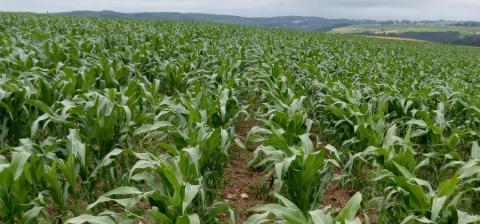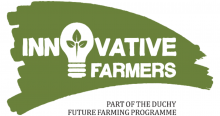Maize is commonly grown in the southwest as a fodder crop for the dairy industry, and increasingly as a biofuel crop. Traditionally maize is established through heavy cultivation, usually including ploughing and power harrowing, because the seed needs a fine seedbed for maximum soil-seed contact.
Because the crop is very uncompetitive in its early stages of growth, particularly the first month, rows are usually wide apart and sprayed with herbicides to limit the growth of competitive ground cover. This means a maize field has a lot of bare soil in the early months of growth, and usually all the way up to and including harvest. It is harvested relatively late in the season, often into October, when the weather is often wetter.
The heavy cultivation used, lack of ground cover, wide rows, shallow roots and late harvest period combine to leave the soil in maize fields vulnerable to erosion and runoff throughout the long growing season and especially at harvest.
However, there are benefits to growing maize. It uses water efficiently which is important given increasingly unpredictable weather systems. It is also known to sequester high levels of carbon. Maize is a very valuable silage crop due to its high starch, high energy, intake potential and high dry matter yield potential.
The objective of the trial:
The objective of the trial is to demonstrate that the negative impacts of growing maize can be reduced by:
- Minimising cultivation through strip tilling: Strip tilling maize rather than conventionally ploughing means the soil is far less disturbed, and should therefore maintain a better structure, making it less vulnerable to high rainfall events. Less soil disturbance should also build soil organic matter and soil carbon. Less cultivation should also make establishment cheaper through reduced fuel use and labour hours.
- Under sowing the maize with an optimal cover crop: Growing cover crops throughout the year, rather than just growing the mandatory green cover overwinter following maize harvest, should provide better soil protection. Different species and mixes of cover crops will have different impacts on the soil and the crop, as will their management. The trial will test which cover crops work best so as not to compete with the maize (especially in the early stages of maize growth). Hopefully we will find a species and management method which can potentially be used to maintain a perennial cover crop providing year-round cover.
- Making the most efficient use of nutrients: The group had a number of questions about how to apply artificial fertiliser most efficiently: as a liquid or a solid. Also whether you could use farmyard manure in a strip till context, and how using digestate fits in. We will incorporate these questions into some of the trials. Additionally it is hoped that by growing legume rich cover crops you could reduce nitrogen fertiliser on the maize crop.
- Measuring carbon uptake and storage: how much carbon is stored by maize within the soil (maize is a C4 plant so this is more easily done than other combinable crops)




